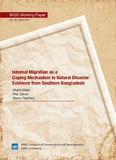| dc.contributor.author | Matin, Maria | |
| dc.contributor.author | Zahan, Iffat | |
| dc.contributor.author | Rabbani, Atonu | |
| dc.date.accessioned | 2022-01-11T06:36:26Z | |
| dc.date.available | 2022-01-11T06:36:26Z | |
| dc.date.copyright | 2017 | |
| dc.date.issued | 2017-04 | |
| dc.identifier.uri | http://hdl.handle.net/10361/15866 | |
| dc.description.abstract | The study focuses on the impact of exposure to a natural disaster on migration. Here, we focus on a very specific type of migration where the households send household member(s) outside the community for earning purposes. We study this in the context of a tropical cyclone called Aila in the southern coastal region of Bangladesh. We find the household’s decision to migrate is systematically associated with exposure to a natural disaster. We find this association for both self-reported exposure to the natural disaster and also with the intensity of the exposure measured by total loss normalized by the total asset of the household. We further find that households induced by the disaster to have a migrant member have less to gain from the migration compared to households who would otherwise migrate in absence of the disaster, suggesting evidence of sorting in migration decision. Public policy should recognize the importance of migration as a possible crisis coping instrument and also take into consideration the possible selection when designing policy to help people vulnerable to extreme weather and climate change. | en_US |
| dc.language.iso | en_US | en_US |
| dc.publisher | BRAC Institute of Governance and Development (BIGD) | en_US |
| dc.relation.uri | https://bigd.bracu.ac.bd/publications/internal-migration-as-a-coping-mechanism-to-natural-disaster-evidence-from-southern-bangladesh/ | |
| dc.subject | Crisis coping | en_US |
| dc.subject | Internal migration | en_US |
| dc.subject | Natural disaster | en_US |
| dc.title | Internal migration as a coping mechanism to natural disaster: Evidence from southern Bangladesh | en_US |
| dc.type | Working Paper | en_US |

